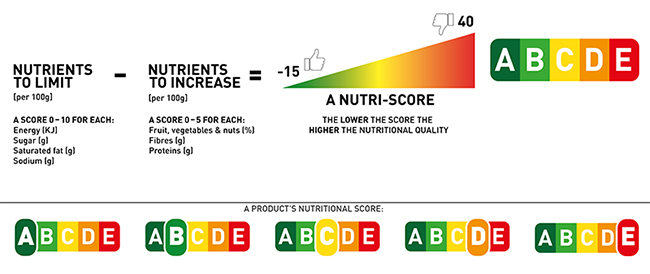What is Nutri-Score?
Nutri-Score is a food rating system used in a number of European countries that shows the nutritional value of a food or drink. The rating goes from A (dark green) to E (dark orange), with A being the best score and E the lowest. The rating must be displayed clearly on the front of packaging.
The goal is to enable consumers to easily compare products and make informed, healthy choices, but also to motivate manufacturers to improve the nutritional profile of their products and help healthcare professionals in their nutrition counselling.
Where is it currently used?
Nutri-Score was developed in France, where it was adopted in 2017. Belgium and Spain followed in 2018 and it is also used by some producers in Germany and the Netherlands. It is currently a voluntary system, but there are now calls for it to become mandatory across all EU countries.
Which products are given a Nutri-Score?
Nutri-Score is intended for all processed food and drink, with some exceptions such as tea, coffee, alcohol and herbs, or products with a packaging surface of less than 25 cm². If a producer opts in, they cannot pick and choose which of their products to include it on – they must include it for all of them.
How is it calculated? A mathematical formula is used to determine a product’s Nutri-Score rating. The product receives a number of points (from 0-40) depending on the amount of “bad” nutrients it contains, i.e. nutrients that should be limited or consumed in moderation, such as calories, sugars, salt. It then gets a second set of points (from 0 to 15) for the amount of “good” nutrients, e.g. fruit, vegetables, proteins, fibres. The second number is subtracted from the first to give the overall score. The lower the overall score, the better the Nutri-Score rating.
The formula is slightly different for drinks and certain food products, such as cheeses. You can see the full set of formulas here.
Why should food and drink manufacturers work towards achieving better ratings?
Obesity and type 2 diabetes, and the associated health risks, are on the rise in Europe and beyond – by reformulating recipes to reduce sugar, fat and calories and increase the fibre content, food and drink manufacturers can play an important role in slowing and reversing this trend. More nutritious products that receive a better Nutri-Score rating are, first and foremost, beneficial for public health.
In addition to the contribution manufacturers can make to healthy living, a better Nutri-Score rating for their products can also give them a competitive edge: research shows that, in France, 7 out of 10 people look at the Nutri-Score, while 84% say they are likely or very likely to purchase a product with a good score1.
Lastly, the European Commission is considering whether the Nutri-Score rating system (or an alternative one) should be adopted EU-wide, potentially on a mandatory basis. It could therefore pay to start thinking now about current ratings and ways to improve them, in preparation for a potential situation where the rating system is adopted more widely.
What about other front-of-pack labelling systems
Other countries use different systems, such as the traffic light system used in the UK and Ireland (and upon which the Nutri-Score was based), and the keyhole logo in Norway, Sweden, Denmark, Iceland, Lithuania and Macedonia.
Ultimately, whichever labelling system a country uses, they all have the same goal: to help consumers make more informed dietary choices. It is in the interest of public health, and of manufacturers themselves, that products are as healthy and nutritious as possible.
How to improve the Nutri-Score of your products
Are you a food and drink manufacturer? Would you like help calculating the current Nutri-Score rating of your products or support improving their nutritional profile? We are experts in reformulation and product innovation. We partner with companies of all sizes to make their products healthier – without compromising on taste.
Contact us below to find out more!
1 Tate & Lyle Proprietary Research, 2020 Global Ingredient Consumer Perception Research – UK, France and Germany.


